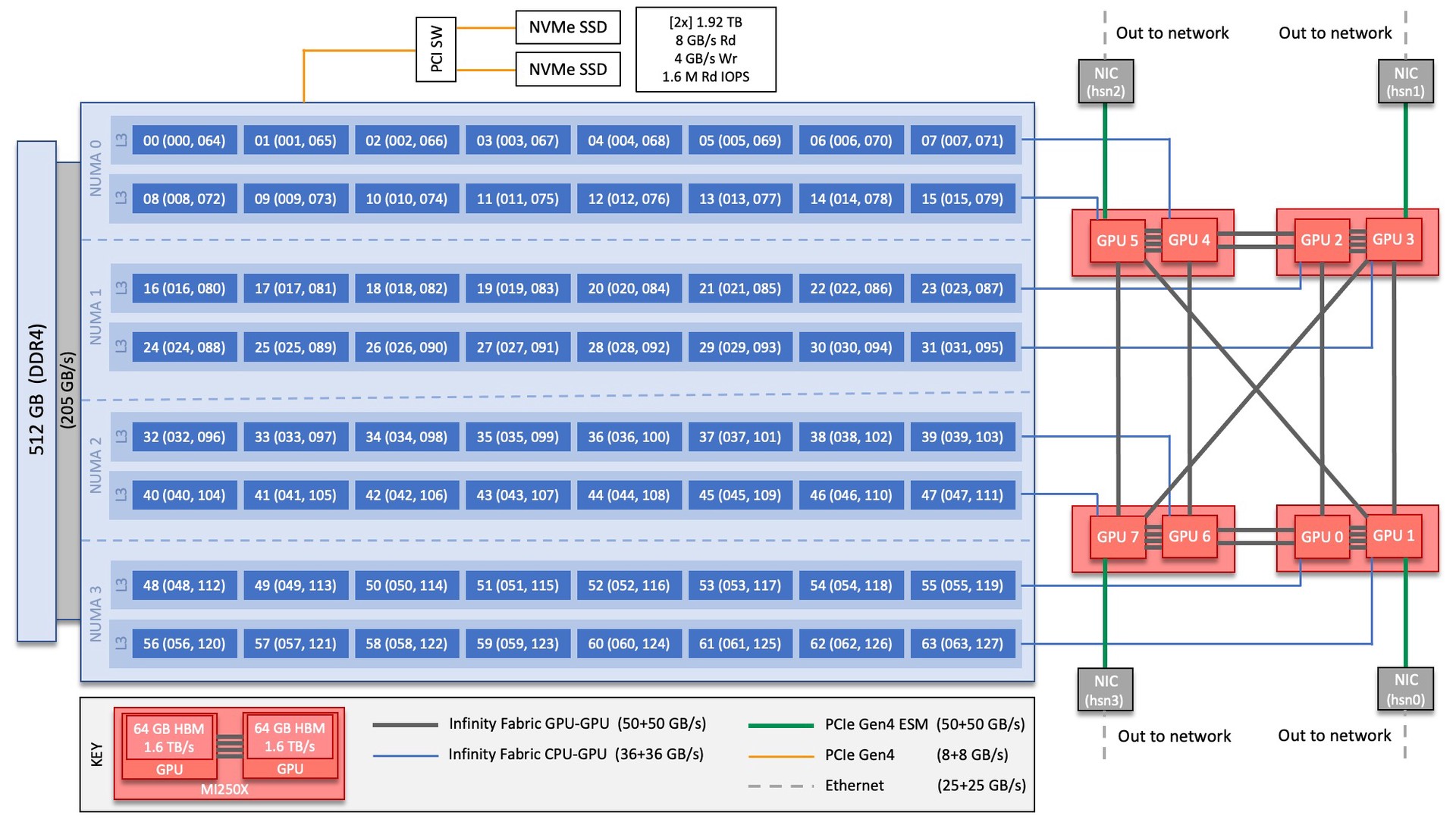Frontier is a Cray EX supercomputer composed of MI250X GPUs operated by the Oak Ridge Leadership Computing Facility. It achieved a max HPL score of 1.206 EFLOPS.
System overview
Frontier has:
- 9,408 Cray EX235a compute nodes1
- 9,408 AMD Trento CPUs (Epyc 7A53)
- 37,632 AMD MI250X GPUs
- 74 cabinets
Frontier uses a Slingshot fabric in a dragonfly topology.
Interestingly, a fully populated 74-cabinet Cray EX4000 with Cray EX235a nodes should have a total of 9,472 nodes. 64 nodes, or a half rack, are missing.
Node architecture
Each Cray EX235a node has:
- 1x AMD Trento CPU
- 64 Zen 3 cores
- 2x threads/core
- 2.0 GHz base, 3.7 GHz max
- 512 GB DDR4 DRAM, 205 GB/s peak bandwidth
- 2x 2 TB NVMe SSDs
- 4x AMD MI250X GPUs
- 128 GB HBM2e (64 GB per GCD)
- 3.2 TB/s peak HBM bandwidth
- 4x Slingshot-11 NICs
Here is a diagram stolen from the Frontier User Guide:

Each physical GPU appears as two separate GPUs to the Linux environment—one per GCD. Because of this, ORNL says each node has eight GPUs, while AMD says each node has four.
Network architecture
Each Cray EX4000 cabinet is a dragonfly group with:2
- 128x compute nodes
- 32x 64-port 200G Slingshot switches
- 4 NICs per node
Each switch has:3
- Up to 16 ports down to endpoints (L0)
- 31 ports to other switches in the rack (L1)
- Up to 16 ports to other groups (L2)
So per group, there are3
- 512 ports down to endpoints
- 992 ports connecting intra-group switches
- Up to 512 ports connecting inter-group switches
Each group has 4 links to every other group, resulting in a blocking factor of 1.753:3
- Each group has injection bandwidth of 512x200G from endpoints, or 102.4 Tb/s
- Each group has ejection bandwidth of 4x200G to 73 other groups, or 58.4 Tb/s
Blocking factor
Storage subsystem
Frontier’s file system is named Orion, and it is a massive, multi-tier Lustre file system built from Cray ClusterStor E1000. It is directly integrated on to Frontier’s dragonfly network and contains:4
- 2x ClusterStor management nodes
- 2x MGS nodes
- 40x MDS nodes
- 450x OSS nodes
- 160x LNET router nodes (for connectivity to external systems)
- 12x utility nodes
- 80x Slingshot switches
- 35x management switches
Each scalable storage unit (SSU) is:
- 1x Cray E1000
- 24x 3.84 TB NVMe drives
- 2x nodes, each with
- 1x AMD Rome CPU (32-core)
- 256 GB DDR4
- 2x Slingshot-11 NICs in PCIe form factor
- 2x 4U106 SAS enclosures (212x 18 TB HDDs)
These SSUs are composed into an SSC (scalable storage cluster?). One SSC is a dragonfly group and has:
- 45x SSUs
- 32x LNet router nodes
- 8x MDS nodes in four E1000s. Each node has
- 1x AMD Rome CPU (32-core)
- 256 GB DDR4
- 2x Slingshot-11 NICs
- Half of the E1000’s 24x 30 TB NVMe drives
- 5x management switches
- 16x Slingshot switches
The full file system has five such SSCs (five dragonfly groups) for a total of:
- 5,400x 3.84 TB NVMes in OSTs
- 20,736 TB raw
- 11,400 TB formatted
- 47,700x 18 TB HDDs in OSTs
- 858,600 TB raw
- 667,600 TB formatted
- 480x 30.72 TB NVMes in MDTs
- 14,745.6 TB raw
- 9,700 TB formatted for Data-on-MDT (DoM)
Though this is a ClusterStor file system, it runs ZFS and dRAID instead of ldiskfs and Cray’s proprietary GridRAID.